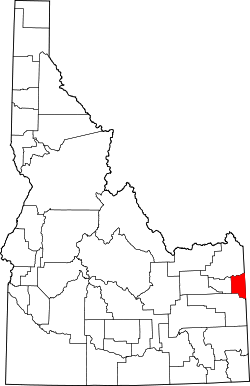2000 census
As of the census [11] of 2000, there were 5,999 people, 2,078 households, and 1,464 families living in the county. The population density was 13 people per square mile (5.0 people/km2). There were 2,632 housing units at an average density of 6 units per square mile (2.3 units/km2). The racial makeup of the county was 91.32% White, 0.17% Black or African American, 0.55% Native American, 0.18% Asian, 0.23% Pacific Islander, 6.73% from other races, and 0.82% from two or more races. 11.75% of the population were Hispanic or Latino of any race. 25.5% were of English, 15.8% German, 7.6% American and 5.1% Irish ancestry.
There were 2,078 households, out of which 39.70% had children under the age of 18 living with them, 60.30% were married couples living together, 5.80% had a female householder with no husband present, and 29.50% were non-families. 21.30% of all households were made up of individuals, and 5.30% had someone living alone who was 65 years of age or older. The average household size was 2.87 and the average family size was 3.43.
In the county, the population was spread out, with 31.80% under the age of 18, 8.10% from 18 to 24, 33.80% from 25 to 44, 18.90% from 45 to 64, and 7.50% who were 65 years of age or older. The median age was 31 years. For every 100 females, there were 112.70 males. For every 100 females age 18 and over, there were 114.50 males.
The median income for a household in the county was $41,968, and the median income for a family was $45,848. Males had a median income of $32,309 versus $22,243 for females. The per capita income for the county was $17,778. About 9.70% of families and 12.90% of the population were below the poverty line, including 18.10% of those under age 18 and 7.90% of those age 65 or over.
2010 census
As of the 2010 United States census, there were 10,170 people, 3,651 households, and 2,509 families living in the county. [12] The population density was 22.6 inhabitants per square mile (8.7/km2). There were 5,478 housing units at an average density of 12.2 units per square mile (4.7 units/km2). [13] The racial makeup of the county was 85.6% white, 0.5% Asian, 0.3% American Indian, 0.2% black or African American, 0.1% Pacific islander, 11.7% from other races, and 1.5% from two or more races. Those of Hispanic or Latino origin made up 16.9% of the population. [12] In terms of ancestry, 29.9% were English, 20.3% were German, 13.0% were Irish, and 4.2% were American. [14]
Of the 3,651 households, 39.3% had children under the age of 18 living with them, 58.9% were married couples living together, 5.9% had a female householder with no husband present, 31.3% were non-families, and 21.9% of all households were made up of individuals. The average household size was 2.78 and the average family size was 3.33. The median age was 33.2 years. [12]
The median income for a household in the county was $53,364 and the median income for a family was $56,791. Males had a median income of $39,865 versus $31,966 for females. The per capita income for the county was $23,633. About 5.4% of families and 7.4% of the population were below the poverty line, including 7.8% of those under age 18 and 2.2% of those age 65 or over. [15]



